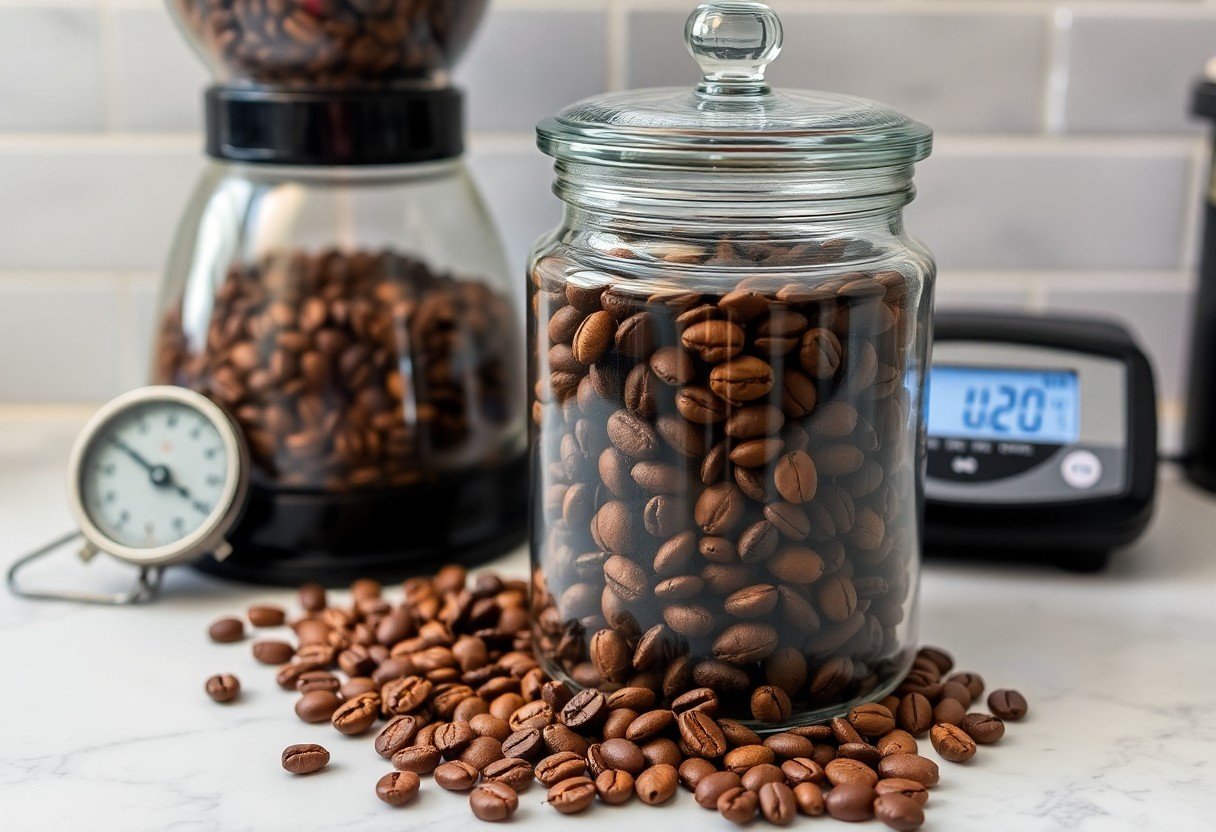You may have noticed that the rich aroma of your freshly opened coffee beans begins to fade over time. Understanding how long your coffee beans can retain their aromatic qualities is crucial for maximizing your enjoyment of each cup. This guide will provide you with insights into the factors influencing the longevity of your coffee beans’ freshness, including storage methods, bean types, and the effects of time. By knowing what to look for, you can ensure that your daily brew remains as delightful as the day you purchased it.
The Chemistry of Aroma: What Makes Coffee Beans Scented?
Understanding the aromatic profile of coffee beans offers insight into why they vanish over time. Coffee’s scent is primarily the result of volatile compounds released during brewing and roasting. These compounds encompass a range of chemical substances, each contributing different fragrances and flavors that interplay together to create the beloved aroma you experience while brewing your morning cup.
Key Chemical Compounds Responsible for Aroma
Several key compounds contribute to the rich aroma of coffee beans, including aldehydes, esters, and pyrazines. For instance, 2-furfurylthiol is a particularly potent compound identified for its distinct and appealing aroma reminiscent of toasted bread. Other compounds like acetic acid and vanillin also add complexity, enhancing the sensory experience you enjoy with every sip.
The Role of Roast Level in Aromatic Qualities
The roast level of your coffee beans significantly influences their aromatic properties. Light roasts tend to preserve more of the original green bean characteristics, yielding brighter and fruitier aromas. In contrast, darker roasts intensify caramelization and develop deeper, bolder scents, often resulting in earthy or smoky notes. Your choice of roast level can dramatically shape the aromatic profile of your cup.
The roast level directly affects the Maillard reaction, which is a process that occurs when sugars and amino acids react under heat. Light roasts, typically exposed to lower temperatures for shorter durations, will retain more of the beans’ natural aromas while highlighting fruity or floral components. Conversely, with darker roasts, the extended heat transforms these compounds, introducing new notes such as chocolate or nutty aromas, which can mask the brighter characteristics found in unroasted beans. This transformation helps you discover diverse flavor profiles with different roast levels and understand how they can elevate your coffee experience.
The Shelf Life Dilemma: How Long Can Beans Retain Their Fragrance?
As you investigate into the world of coffee, understanding the aromatic longevity of beans becomes important. Coffee beans can retain their delightful fragrance for varying lengths of time, profoundly affected by various factors. Although roasted beans might seem robust, they are more susceptible to rapid degradation than you may think. On average, coffee beans maintain their aromatic qualities for two to three weeks after roasting, but optimal flavor peaks within the first week. Beyond this period, a notable decline in fragrance and flavor occurs.
Factors Impacting Longevity of Aroma
A multitude of factors can impact how long those enticing coffee aromas linger. Consider these elements:
- Roast date— fresher beans mean more aroma.
- Storage conditions— air, moisture, and light can degrade quality.
- Bean type— lighter roasts generally retain aroma longer.
- Processing method— washed beans might last longer compared to natural ones.
Assume that by paying attention to these factors, you can extend the aromatic lifespan of your coffee beans.
Shelf Life Differences: Whole Beans vs. Ground Coffee
Whole beans and ground coffee differ significantly in their shelf lives. Whole beans tend to preserve their aroma and flavor for much longer—up to several weeks—if stored properly. Ground coffee, however, has a much shorter shelf life, typically lasting only a few days to a week before losing its aromatic qualities. The increased surface area of ground coffee allows for faster oxidation and degradation, meaning it’s important to grind your beans right before brewing for the best taste experience.
When considering shelf life, the contrast between whole beans and ground coffee highlights the importance of freshness. Whole beans contain important oils and compounds that remain nicely sealed within their structure, protecting them from losing their fragrance. In contrast, once coffee is ground, it exposes those oils to air, moisture, and light, accelerating the deterioration of aroma and flavor. Investing in a quality grinder can therefore transform your coffee routine, enabling you to enjoy the rich fragrances and tastes that only freshly ground coffee can deliver.

Environmental Enemies: What Deteriorates Aroma in Coffee Beans?
Your coffee beans are vulnerable to several environmental elements that can swiftly strip away their aromatic qualities. Each factor plays a significant role in how long those delightful scents linger. When exposed to detrimental conditions, the beans may lose their flavor and aroma, making your morning cup less enjoyable.
Effects of Oxygen, Light, and Moisture
Oxygen is particularly notorious for oxidizing coffee beans, leading to stale flavors. Direct sunlight can further amplify this process by breaking down aromatic compounds, while moisture creates an environment for mold and spoilage, ruining the beans completely. Keeping beans in airtight containers, away from light and moisture, is imperative to maintain their freshness.
The Impact of Temperature on Freshness
Temperature can drastically influence the quality of your coffee beans. High temperatures accelerate the degradation of aromatic compounds, leading to a loss in flavor and scent. Ideally, coffee beans should be stored in a cool, dry place, away from heat sources, which helps prolong their aromatic experience considerably.
Factors Affecting Freshness
| Factor | Effect on Aroma |
|---|---|
| Oxygen | Causes oxidation, leading to stale flavors. |
| Light | Degrades aromatic compounds, resulting in loss of scent. |
| Moisture | Creates ideal conditions for mold, ruining beans. |
| Temperature | Accelerates degradation of flavors and aromas. |
Understanding temperature’s effect on freshness means you can take proactive steps to keep your coffee beans in optimal condition. Ideal storage temperatures range between 60°F and 70°F (15°C to 21°C), as exposure to higher temperatures can lead to rapid aroma deterioration. Regularly checking the storage environment can help you enjoy every cup to its fullest potential.
Optimal Temperature Range
| Temperature (°F) | Effect on Beans |
|---|---|
| Below 60°F | Can cause condensing moisture, leading to mold growth. |
| 60°F to 70°F | Ideal for preserving freshness and aroma. |
| Above 70°F | Increases risk of flavor degradation. |
Preservation Techniques: How to Maximize Coffee Aroma
By adopting effective preservation techniques, you can significantly extend the aromatic life of your coffee beans. Methods such as proper storage, temperature control, and packaging solutions play an important role in maintaining the freshness and fragrance of your beans. Ensuring that you follow these strategies will not only enhance your coffee-drinking experience but also save you money by reducing waste.
Best Storage Practices for Coffee Beans
To keep your coffee beans aromatic and flavorful, store them in an airtight container in a cool, dark place. Avoid exposing them to heat and light, which can accelerate the deterioration process. Glass jars, ceramic containers, and vacuum-sealed bags are ideal, as they provide a protective barrier against oxygen and moisture. Additionally, buy coffee in smaller quantities so you can enjoy it at its freshest with minimal waste.
The Use of Vacuum Sealing and Other Packaging Solutions
Vacuum sealing is an effective method of preserving coffee aroma by removing air from the packaging, thus slowing oxidation. Many coffee brands now offer their products in vacuum-sealed bags, which help retain freshness for longer periods. Alternatively, nitrogen-flushed pouches displace oxygen and provide a protective atmosphere that enhances the longevity of your coffee. Consider investing in a countertop vacuum sealer to maximize the freshness of your coffee beans at home.
Indeed, vacuum sealing not only extends shelf life but also preserves the complex flavor profiles inherent in high-quality beans. This technique keeps the beans from becoming stale and protects the oils that contribute to a robust aroma. While vacuum-sealed packaging is beneficial for long-term storage, don’t forget to transfer smaller amounts into your daily-use container to ensure you enjoy the freshest cup possible. By integrating these packaging solutions into your routine, you can savor the coffee aromas longer and enjoy a richer, more satisfying experience with each brew.
A Fresh Perspective: Rethinking Coffee Bean Freshness
Most coffee enthusiasts assume that freshness is solely defined by a narrow window of time after roasting. However, viewing freshness as a continuum can enhance your coffee experience. Various factors—including storage conditions, grind size, and brewing methods—play significant roles in preserving aroma and flavor over time. Experimenting with different parameters can lead to a deeper appreciation of your coffee, allowing you to discover nuances that often go unnoticed in the chase for the “freshest” beans.
The Importance of Freshness in Brew Quality
Fresh coffee beans directly influence the brew quality, impacting both aroma and flavor. When you brew with recently roasted beans, you’ll often notice vibrant notes and rich complexities, enhancing your overall experience. Conversely, as beans age, even slightly, their flavors can dull, leading to a flat or stale cup. Prioritizing freshness can therefore elevate your daily coffee ritual and enhance the joys of brewing.
Understanding the “First Sip” Phenomenon Over Time
The “first sip” phenomenon encapsulates the immediate impact fresh coffee has on your palate. Right after brewing, those aromatic compounds and flavors burst through, creating an exhilarating experience. But as time elapses, even a few minutes post-brew, the volatile components start to dissipate, altering the coffee’s taste profile. It’s fascinating to note how just a short window can shift your perception of what that coffee truly offers.
After brewing, the initial sensory explosion you experience is a result of the aromatic compounds uniquely present in fresh coffee. These compounds are volatile and degrade quickly, leading to a noticeable decline in flavor and scent within minutes. As you sip over time, you might find that rich floral notes morph into something more muted, or acidity fades away, leaving behind a shadow of its former glory. This shift enhances the significance of brewing immediately after grinding while still maintaining quality in the aftermath of the first sip.
Conclusion
Summing up, the aromatic qualities of coffee beans typically begin to diminish within two to four weeks after roasting, depending on your storage conditions. To maximize freshness, you should store your beans in an airtight container away from light, heat, and moisture. Enjoying your coffee at its peak flavor means using your beans within this timeframe. By being mindful of these factors, you’ll ensure a delightful coffee experience with every brew.
Q: How long do coffee beans stay fresh and aromatic after roasting?
A: Generally, coffee beans reach their peak aroma and flavor within the first two to four weeks after roasting. During this period, they can produce the most vibrant flavors and aromas, due to the release of carbon dioxide, which occurs post-roasting. After this time, while the beans may still be drinkable, the freshness diminishes, leading to a decline in the aromatic qualities and flavor profiles.
Q: What factors can influence the longevity of coffee bean freshness?
A: Several factors can affect how long coffee beans maintain their aromatic qualities. Exposure to air, light, heat, and moisture can accelerate the degradation process. Ideally, beans should be stored in an airtight container in a cool, dark place to prolong their freshness. Additionally, the bean’s origin and roast level also play a role: lighter roasts often retain their aroma for slightly longer than darker roasts due to differences in oil content and composition.
Q: How can I tell if my coffee beans have gone stale?
A: Indications that coffee beans may have lost their aromatic properties include a flat or dull smell, often accompanied by a lack of flavor when brewed. Fresh beans typically emit a strong, pleasant aroma when ground. If the beans feel excessively dry and lack an oily sheen, it’s a sign they may have passed their optimal freshness period. Always check for these qualities to ensure the best brew experience.

